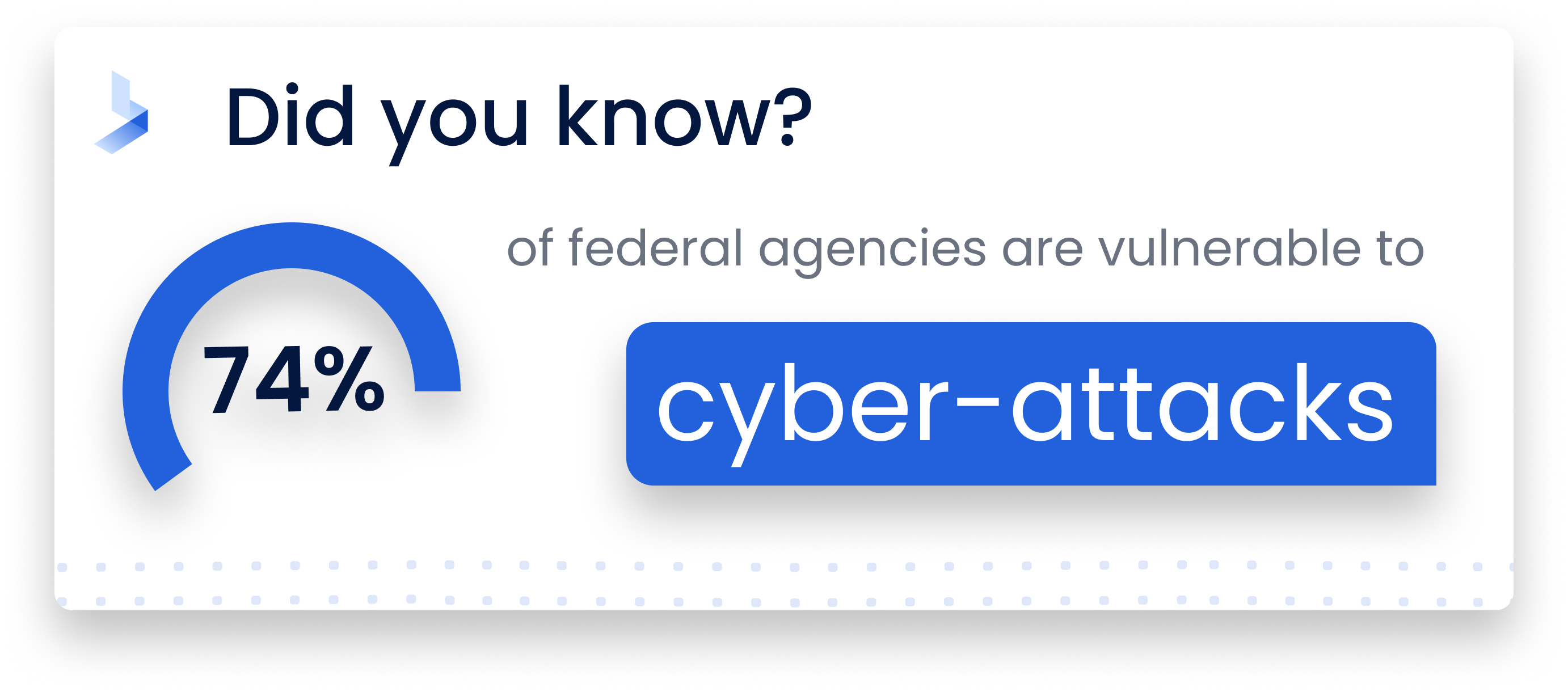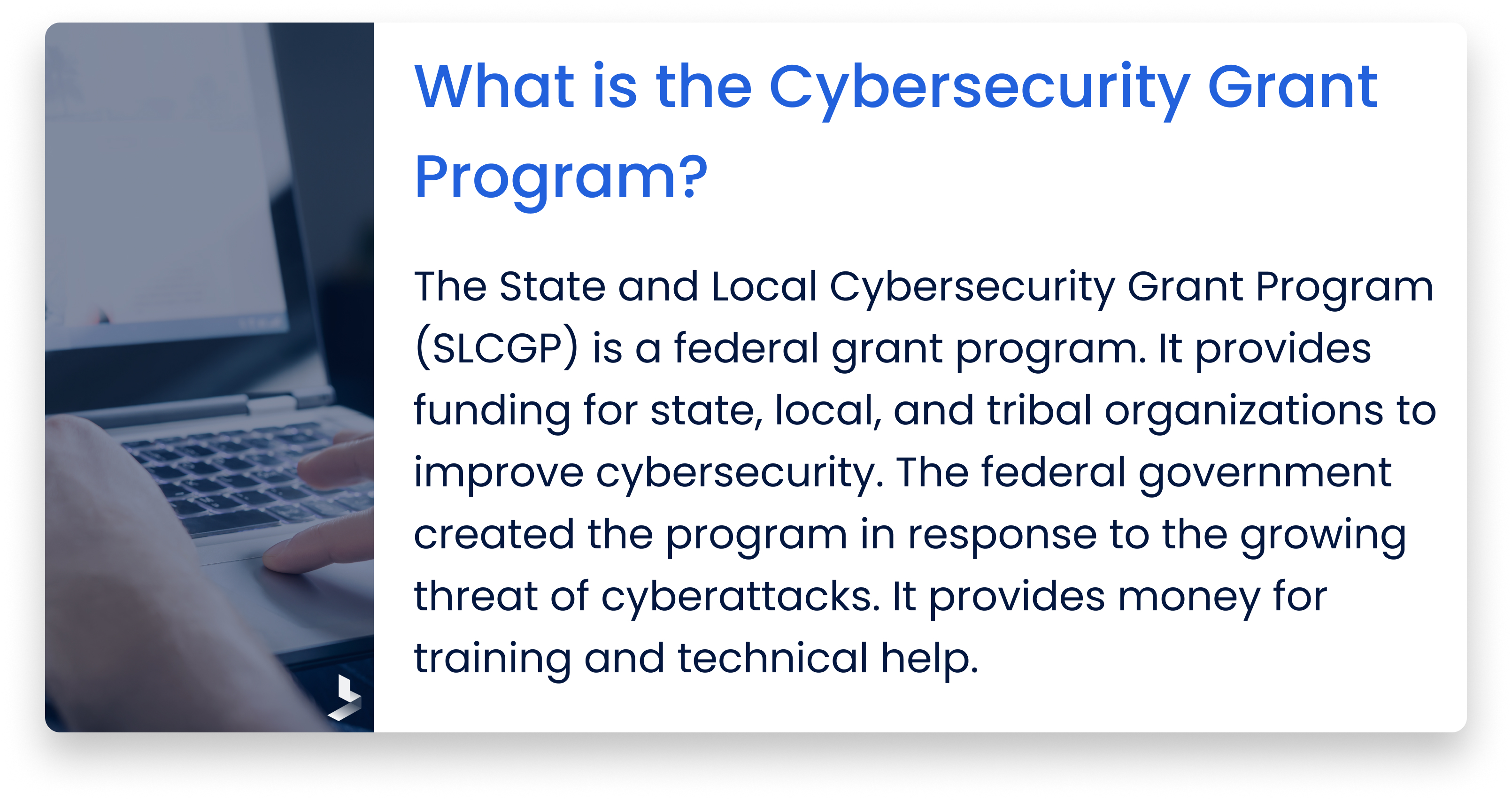Cybersecurity Grant Program: The Complete Guide

 By
Emily Miller
·
7 minute read
By
Emily Miller
·
7 minute read
You know cybersecurity is important for your organization, but how do you afford it? Even though cybersecurity can be costly, there is a new program available to help with the cost.
The Cybersecurity Grant Program is a game changer for organizations. It helps state, local, and tribal entities keep their online information safe. Keep reading to find out more about the program, how to apply for it, and a few cybersecurity tips.
What Is Cybersecurity?
Cybersecurity is the practice of protecting electronic information from unauthorized access or theft. It can include anything from personal data to confidential company information.
Cybersecurity is vital for businesses and organizations of all sizes. Hackers are always finding new ways to break into systems. So, keeping up with the latest online security measures is essential. Preventing hackers from breaking into your system should be the number one priority.
An Increased Threat of Cyber Attacks
There is an increased threat of cyber attacks from foreign governments and cybercriminals. Let's take the Chinese government, for example. It was determined to be behind an attack on the government networks of several U.S. states and other countries.
The Chinese government carried out the attack through the use of vulnerable web applications such as Log4j. It allowed hackers to gain access to sensitive data.
The attacks also include DDoS attacks. These attacks knocked out internet services for an entire week in the Marshall Islands.
Also, two hacker groups from the Pakistan government targeted the Indian government. These groups are suspected of sending phishing emails and spreading malware.
Other cyber attacks involve malware that encrypts data on the target system and demands a ransom to unlock it. These attacks can range from low-level nuisances to more severe incidents. For instance, a cyber attack locked down municipal government data in Atlanta last year. As a result, they encourage individuals to scan email attachments for malware before saving them to their systems. They should also limit the administrator rights of their systems.
The Russian government is also a haven for cybercriminals. They aim to target organizations outside of Russia. In fact, four high-profile cyber attacks in the U.S. are believed to have come from Russian state-sponsored cybercriminals.
The U.S. government is taking cyber attacks very seriously. A recent assessment found that 74% of federal agencies are vulnerable to cyber-attacks. This means they need immediate improvements in their security. The increased threat is also causing governments to step up their efforts to prosecute cyber criminals.

Benefits of Cybersecurity
There are many benefits of implementing cybersecurity measures. Organizations can enjoy increased protection of their networks and data. It reduces downtime and decreases costs associated with recovery from a breach. Other benefits include:
- Protecting sensitive information: It keeps it from falling into the wrong hands.
- Protecting your reputation: A data breach can damage your company's reputation. By implementing cybersecurity measures, you can help protect your good name.
- Safeguarding your confidential information: Cybersecurity can help you keep your data safe. This is important for maintaining their trust.
- Avoiding costly fines: Many industries are subject to strict regulations. They must put in place certain cybersecurity measures. If you don't comply, you could face hefty fines.
Besides, employees can have greater peace of mind. They'll know the organization is taking steps to safeguard their information. Implementing cybersecurity measures can also help build trust with the public.
What Is the Cybersecurity Grant Program? Who Is It For?
The State and Local Cybersecurity Grant Program (SLCGP) is a federal grant program. It provides funding for state, local, and tribal organizations to improve cybersecurity.
The federal government created the program in response to the growing threat of cyberattacks. It provides money for training and technical help.
Local Governments
The SLCGP provides funding for the development of cybersecurity plans. But, local entities must include their own input into these plans.
The SLCGP reduces cybersecurity risk across eligible entities. It's critical to incorporate local input into the overall plan. It helps ensure the success of the program.
The SLCGP also provides funding for emergency communications investments. But, it is imperative to consider how sustainable these investments will be in the future. Organizations want to feel confident in these investments once the grant program ends.
Rural Areas
A rural area is defined as an area with a population of 50,000 or fewer. It also includes an area that is not defined as an urbanized area by the Secretary of Commerce. By defining a rural area, the program makes it easier for local government organizations to apply for grant money.

Is My Organization Eligible?
To be eligible, states, districts, and territories can apply for up to $185 million each in FY 2022. Their plans should be comprehensive and include:
- The layout of their current cybersecurity landscape in detail
- Information about how they plan to improve resilience against threats as well as
- Their plan for continuous assessments of vulnerabilities
The grant program provides $1 billion over four years to state and local governments.
How to Qualify
To qualify for the grant program, states must develop a cybersecurity plan. The plan must meet specific criteria, and the state's CISO and CIO must approve it.
Also, a cybersecurity planning committee must approve it. The committee will consist of cybersecurity professionals who represent key stakeholder groups.
The plan must include high-level goals and finite objectives. The plan should be the overarching framework for the entity's overall cyber resilience.
Once this is complete, grant-funded projects should align with these goals. It is also important to consider regional approaches when developing a cybersecurity plan.
How Is Funding Dispersed?
States must apply for a portion of the funding, and they must pass down 80% of the funds to local governments. Also, a minimum of 25% must be set aside for rural areas.
The grants require state and local governments to develop comprehensive cybersecurity plans. These plans should use powerful countermeasures and Zero Trust strategies.
State and Local Cybersecurity Grant Program: Applying for Funding
To apply for the SLCGP, state and local governments must apply through Grants.gov. The program asks organizations to submit their applications by November 15, 2022.
Applicants must provide detailed information about their jurisdiction's cybersecurity posture. Also, they should include their needs and planned projects. But, the program still encourages entities that don't yet have a plan to still apply. They will need to complete the plan in Year One.
Organize a Cybersecurity Planning Committee
To receive grant funds, all eligible organizations must organize a cybersecurity planning committee. This is a requirement under the SLCGP.
The planning committee should include representatives from various entities and must be inclusive. It is important to select members with information security and technology experience.
The committee should focus on building cybersecurity capabilities across the eligible entity. Also, the committee should have the necessary points of contact for FEMA.
Next, the entity should provide the planning committee with information to the federal government. It's included as part of its grant application.
The state award funds can be used to support a cybersecurity planning committee. For example, entities could use the funds to hire planners. They can also establish IT management structures, identify projects, and conduct research. Be sure to consider how you'll spend this money, as well as any other sources of funding.
Cybersecurity Plan Development
Cybersecurity plan development is a vital step in ensuring cyber safety. It should include a strategic mission and key stakeholder evaluation. The cybersecurity mission must align with the organization's overall goals.
The committee will need to decide what cybersecurity projects to pursue. Its cybersecurity plan should guarantee the continuity of state government and communications. Also, the plan should provide for a cybersecurity coordination system between state and local entities.
Requirements
Cybersecurity is more than a collection of tools and software. It must consider the entire information system. The program application requires the following to be included:
- Existing plans to protect against cybersecurity risks and threats
- How the entity integrates input and feedback from local governments and their associations
- Describe the state and local government's responsibilities in putting forth the Cybersecurity Plan
- Assess each of the program's required elements
- Outline what necessary resources
- Make a timetable for putting the plan into action
- Define how the entity will measure progress
Also, there are more elements required to be included in the cybersecurity plan. These are listed in the Notice of Funding Opportunity.
Update Internal Communication and Training Material
As the plan evolves, update your internal communication and training material. This will help employees and management communicate the changes.
Make sure that everyone understands the impact of the changes. They'll also need to know how the changes will affect business processes.
| Related Reading: What is a Security Incident Response Plan? |
Building Cyber Resilience
The first step to building cyber resilience is to assess your organization's security posture. This involves compiling a list of all your IT assets. The list should include the business context and vulnerabilities they present. Also, identify the entry points from which cyber-threats can enter your organization.
After you've identified the most vulnerable areas, develop a breach recovery plan. This plan should include robust disaster recovery strategies. Take into consideration how to manage the damage caused by a cyber incident.
Cyber resilience requires a fundamental shift in the way organizations approach security. It focuses on protecting an organization's digital crown jewels. These often include enterprise data and applications.
These assets are often more sensitive than other data and so are more vulnerable to attacks. For this reason, organizations must adopt the best cybersecurity practices. Consider your organization's online security, including security hygiene and encryption.
Organizations should also develop recovery processes and procedures for mission-critical systems. Document these processes and make sure they are accessible electronically. These recovery processes should be regularly tested.
Additionally, organizations should patch their systems to ensure that they're up to date. Incorporate live exercises and cyber recovery tabletops into cyber resilience plans.
Building cyber resilience is a multifaceted process that combines people, culture, and technology. It's crucial to understand the components that support cyber resilience. Organizations should identify the best ways to build and maintain those components.
Afterwards, ask your senior executives to help you define cyber resilience. It helps IT managers determine what activities and resources an organization needs.
Zero Trust Security
Zero Trust security protects an organization's sensitive data at all times. This approach provides real-time data loss prevention and advanced threat protection. It is also scalable and modular.
The technology helps organizations reduce the workload of security analysts. It reduces the number of security controls and limits the attack surface.
Zero Trust security architectures integrate with an organization's IT environment. It improves speed, policy accuracy, and task delegation. Organizations can then break down the architecture into dozens of smaller action steps.
By organizing the architecture by stages, it can be more easily managed. Once the components are in place, organizations can install Zero Trust security.
Zero Trust networks use next-generation firewalls. They segment and isolate the network to limit access and reduce the number of attacks. They make it difficult for attackers to access sensitive data and critical systems.
Zero Trust networks do not allow outside users to connect to internal networks. This is by default.
Zero Trust security also uses multi-factor authentication (MFA). MFA requires users to enter a code sent to a separate device. It eliminates the need to use many logins or passwords to access an enterprise network. Also, Zero Trust security makes it easy to install multi-factor authentication.
| Related Reading: A Complete Guide to Zero Trust Security |
Strengthen Your Organization's Cybersecurity
The Cybersecurity Grant Program helps state and local entities strengthen their cybersecurity structure. By applying for the grant, organizations can stay one step ahead of cybercrime.
Interested in learning more about this program? Contact us today! We'll be happy to discuss how our cybersecurity solutions can help your organization.
